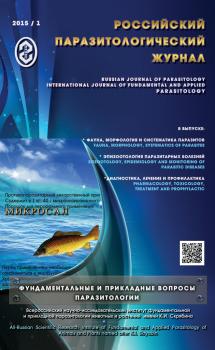Nacional'nyy issledovatel'skiy Tomskiy gosudarstvennyy universitet
Objective of research: to study the inactivation of eggs of Opisthorchis felineus and Diphyllobothrium latum in the water by the narrowband ultraviolet excimer lamp radiation 222 and 282 nm depending on the surface radiation dose. Materials and methods: Helminth eggs were detected by the Kato technique. The revealed eggs were flushed into a plastic container with the distilled water and exposed to UV. The inactivation of eggs was confirmed by the method of optical microscopy. Results and discussion: It was found that the recovery of helminth eggs from water was 40- 70% more efficient by using UV radiation at 222 nm than at 282 nm. In addition, the surface radiation dose at 222 nm (up to 5 mJ/cm2) was one order less than at 282 nm (up to 100 mJ/cm2). Up to 30 % of the initial amount of Opisthorchis felineus eggs were inactivated at 282 nm surface radiation dose (up to 100 mJ/cm2). Up to 85 % of the initial quantity of Opisthorchis felineus eggs were inactivated at 222 nm radiation on the water surface (up to 5 mJ/cm2). Up to 56 % of Diphyllobothrium latum eggs were inactivated at the comparable 222 nm surface radiation dose. Due to the higher photon energy, the more intensive shortwave radiation at 222 nm breaks shells of Opisthorchis felineus eggs more effectively. We have a reason to suppose that some features of Diphyllobothrium latum egg shells make its inactivation at 222 nm less efficient in comparison with the inactivation of Opisthorchis felineus eggs at the same wavelength of radiation.
inactivation, helminth, disinfection, ultraviolet, excimer lamps.
Введение
На территории Сибири широко распространены описторхоз (возбудитель Opisthorchis felineus) и дифиллоботриоз (возбудитель Diphyllobothrium latum). Возбудители этих болезней имеют трехстадийный жизненный цикл. Попадая в водоёмы, яйца этих гельминтов заражают пресноводных моллюсков или зоопланктон. Возбудителем второй стадии являются личинки – мирацидий и процеркоид, вторым носителем – пресноводные рыбы, которые в мышцах и внутренних органах содержат возбудителей третьей стадии – метацеркарии и плероцеркоиды. Конечным носителем является человек и хищные млекопитающие: кошки, собаки, лисицы, песцы, волки, а также свиньи.
1. Avtaeva S.V., Zhdanova O.S., Pikulev A.A. et al. Novye napravleniya v nauchnyh issledovaniyah i primenenii eksilamp. [Recent trends in scientific research and application of excimer lamps]. Tomsk, STT, 2013. 246 p.
2. Bayneva I., Baynev V. From glow lamps to energy efficient light sources: aspects of changeover. Fotonika [Photonics], 2011, no. 6, p. 30.
3. Boychenko A.M., Lomaev M.I., Panchenko A.N. et al. Ul’trafioletovye i vakuumno-ul’trafioletovye eksilampy: fizika, tehnika i primenenija. [Ultraviolet and vacuum ultraviolet excimer lamps: physics, techniques and usage]. Tomsk, STT, 2011. 512 p.
4. Shevtsov D.A., Dolzhenko L.A., Grimaylo L.V. et al. Sposob degel’mintizacii hozjajstvenno-bytovyh stochnyh vod [The way of dehelmintization of domestic waste water]. Patent RF no. 2167825, 2001.
5. Sosnin E.A., Tarasenko V.F., Zhdanova O.S., Krasnozhonov E.P. Excimer lamps - a new instrument for photobiological studies. Biotehnosfera [Biotechnosphere], 2012, no. 3-4, pp. 52-59.
6. Tarasenko V.F., Sosnin E.A., Zhdanova O.S., Krasnozhenov E.P. Applications of excimer lamps in microbiological and medical investigations. Plasma for Bio-Decontamination, Medicine and Food Security (NATO Science for Peace and Security Series A: Chemistry and Biology), Springer, 2012, pp. 251-263.
7. Novye napravlenija v nauchnyh issledovanijah i primenenii jeksilamp / S.V. Avtaeva, O.S. Zhdanova, A.A. Pikulev i dr. - Tomsk: STT, 2013. - 246 s.
8. Metody kontrolya. Biologicheskie i mikrobiologicheskiye faktory. Laboratornaya diagnostika gel’mintozov i protozoozov. Metodicheskie ukazaniya. [Methods of control. Biological and microbiological factors. Laboratory diagnostics of helminthiasis and protozoan diseases. Method. Guidelines approved by [Rospotrebnadzor 26.11.2013], 2013.





